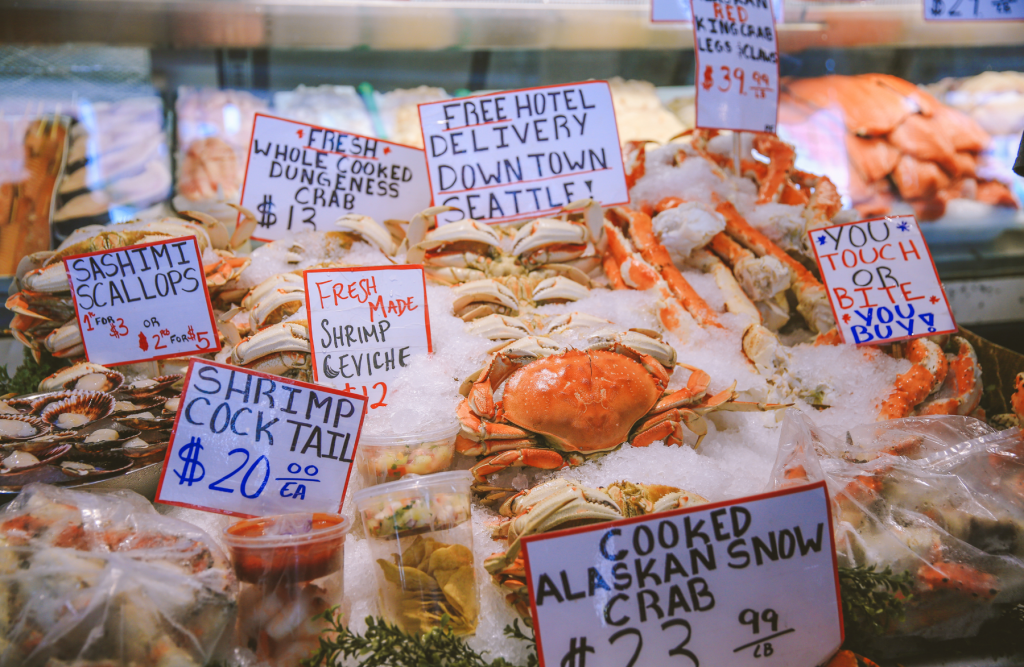
Go Inside Seattle’s Iconic Pike Place Market
Published on February 1, 2024
eATLAS’ Pike Place Market Experience is a date-night/pub crawl to five spots found on Pike Place Market’s Post Alley. Another Seattle adventure is the Strange(r) Seattle in Fremont, our scavenger hunt that visits nine locations in the Fremont neighborhood, which is celebrated for its cool bars and street art.
By Dave Lifton (@daveeatschicago)
To those outside Seattle, Pike Place Market is primarily famous as the location of the first Starbucks and for the fishmongers who throw their goods to each other before being wrapped up. But it’s been an integral part of the city for more than 115 years.
As Seattle grew rapidly at the start of the 20th century, produce wholesalers used the increased demand as an opportunity to gouge prices for customers while giving fewer profits to the farmers. A city councilman named Thomas Revelle proposed a public market in 1907 that would cut out the middlemen. The location was to be on a bluff overlooking Elliott Bay. On Aug. 17th, 1907, a handful of farmers lined up their wagons on Pike Place, and sold out within minutes.
The success immediately attracted more farmers, as well as Frank Goodwin, who owned the Leland Hotel and other properties on Pike Place. Days after the market opened, Goodwin made a deal with the city to permanently house the market inside the hotel. Over the next decade, the market expanded to encompass most of the street, with the Leland becoming the Main Arcade.
From the start, Goodwin and the city, who co-managed the market, ensured that stalls would only go to those directly responsible for the goods. By 1911, there was already a sign above the Main Arcade bearing its now-famous motto: “Meet the Producer.” That policy was eventually altered to allow for produce that couldn’t be grown locally during the winter, such as citrus brought in from California, to be sold to keep the stalls occupied year-round. But the local emphasis allowed the farmers to thrive while keeping the prices low.

As a result, Pike Place Market was successful even during the Great Depression. But the internment of Japanese-Americans during World War II had a devastating impact because the majority of the farmers were of Japanese descent, and many never returned to Seattle upon their release.
The market continued its decline after the war. Farms outside the Seattle area transformed into suburbs, which led to the rise of supermarkets and shopping centers, thereby reducing both supply and demand for the market. The success of the 1962 World’s Fair nearly proved to be its fatal blow. The contrast between the rundown, 55-year-old market and the gleaming, futuristic Space Needle only a mile away was evident. A year later, urban renewal plans called for the market and the surrounding blocks to be replaced by high-rise office buildings and parking garages.
Led by an architect and University of Washington professor named Victor Steinbrueck, a group called Friends of the Market formed and fought back against the redevelopment. In 1971, a ballot initiative to designate the seven acres comprising the market as a historic district passed by a 3-to-2 margin. The act established the Pike Place Preservation and Development Authority (PDA), which has since been tasked with overseeing all aspects of the market.
But sparing the market from the wrecking ball was the first step. The next phase involved a $135 million renovation to revitalize the district. This included turning Pike Place into a more pedestrian-friendly street, connecting the market to the waterfront via the Pike Street Hillclimb, and rehabbing apartments above the market to make the area a more attractive—yet still affordable—place to live. Steinbrueck helped design a park at the northern end of the market, and it was named in his honor after his death in 1985.
The market gives back to the city through its charitable efforts, which include a medical clinic, preschool, senior services, and a food bank for those living in the district. The Pike Place Market Foundation donates funds to social agencies throughout Seattle, and its Community Safety Net provides assistance to vendors and employees who are going through financial hardships. Since 1986, a large, bronze piggybank has lived at the Pike Place entrance, and has collected more than $350,000 in donations.
Pike Place Market underwent another renovation in 2008 that cost $73 million, and 2017 saw the first expansion since the mid-‘80s. Built on the site of the Municipal Market building, which opened in 1922 and was destroyed by a fire in 1975, the MarketFront added 12,000 square feet of retail space, room for 47 farmers and craftspeople, and 40 studio apartments for low-income seniors.
Nowadays, Pike Place Market supports more than 500 small, independent, local business and farmers. And the PDA is currently looking towards the future. In December 2023, the first draft of a Master Plan was made public. The concept is to lay out a sustainable future for the next 50 years and beyond.

The Adventure starts when you say it does.
All eATLAS Adventures are designed and built by experienced eATLAS Whoa!Guides. They're always on. Always entertaining. And always ready to go.
Check out our Adventures!